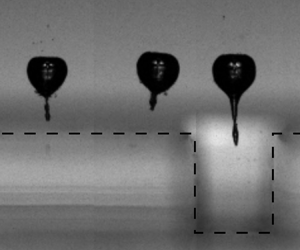Crossref Citations
This article has been cited by the following publications. This list is generated based on data provided by
Crossref.
Koch, Max
Rosselló, Juan Manuel
Lechner, Christiane
Lauterborn, Werner
and
Mettin, Robert
2021.
Dynamics of a Laser-Induced Bubble above the Flat Top of a Solid Cylinder—Mushroom-Shaped Bubbles and the Fast Jet.
Fluids,
Vol. 7,
Issue. 1,
p.
2.
Manmi, Kawa M. A.
Aziz, Imad A.
Arjunan, Arun
Saeed, Rostam K.
and
Dadvand, Abdolrahman
2021.
Three-dimensional oscillation of an acoustic microbubble between two rigid curved plates.
Journal of Hydrodynamics,
Vol. 33,
Issue. 5,
p.
1019.
Li, Shi-Min
Liu, Yun-Long
Wang, Qianxi
and
Zhang, A-Man
2021.
Dynamics of a buoyant pulsating bubble near two crossed walls.
Physics of Fluids,
Vol. 33,
Issue. 7,
Kiyama, Akihito
Shimazaki, Takaaki
Gordillo, José Manuel
and
Tagawa, Yoshiyuki
2021.
Direction of the microjet produced by the collapse of a cavitation bubble located in a corner of a wall and a free surface.
Physical Review Fluids,
Vol. 6,
Issue. 8,
Sun, Yurong
Yao, Zhifeng
Wen, Haigang
Zhong, Qiang
and
Wang, Fujun
2022.
Cavitation bubble collapse in a vicinity of a rigid wall with a gas entrapping hole.
Physics of Fluids,
Vol. 34,
Issue. 7,
Andrews, Elijah D.
and
Peters, Ivo R.
2022.
Modeling bubble collapse anisotropy in complex geometries.
Physical Review Fluids,
Vol. 7,
Issue. 12,
Brujan, Emil-Alexandru
Zhang, A.-M.
Liu, Yun-Long
Ogasawara, Toshiyuki
and
Takahira, Hiroyuki
2022.
Jetting and migration of a laser-induced cavitation bubble in a rectangular channel.
Journal of Fluid Mechanics,
Vol. 948,
Issue. ,
Bokman, G. T.
Biasiori-Poulanges, L.
Lukić, B.
Bourquard, C.
Meyer, D. W.
Rack, A.
and
Supponen, O.
2023.
High-speed x-ray phase-contrast imaging of single cavitation bubbles near a solid boundary.
Physics of Fluids,
Vol. 35,
Issue. 1,
Andrews, Elijah D.
Fernández Rivas, David
and
Peters, Ivo R.
2023.
Bubble collapse near porous plates.
Journal of Fluid Mechanics,
Vol. 962,
Issue. ,
Wang, Jing-zhu
Wang, Guang-hang
Zeng, Qing-yun
and
Wang, Yi-wei
2023.
Recent progress on the jetting of single deformed cavitation bubbles near boundaries.
Journal of Hydrodynamics,
Vol. 35,
Issue. 5,
p.
832.
Yu, Jia-xin
Wang, Xiao-yu
Hu, Jin-sen
Shen, Jun-wei
Zhang, Xiang-qing
Zheng, Xiao-xiao
Zhang, Yu-ning
and
Yao, Zhi-feng
2023.
Laser-induced cavitation bubble near boundaries.
Journal of Hydrodynamics,
Vol. 35,
Issue. 5,
p.
858.
Li, Shi-Min
Zhang, A-Man
Cui, Pu
Li, Shuai
and
Liu, Yun-Long
2023.
Vertically neutral collapse of a pulsating bubble at the corner of a free surface and a rigid wall.
Journal of Fluid Mechanics,
Vol. 962,
Issue. ,
Li Xuekun, 李学坤
Ji Lingfei, 季凌飞
Zhang Litian, 张犁天
and
Zhang Honglong, 张洪龙
2023.
自然骨曲面对激光诱导空泡演化行为规律的影响.
Chinese Journal of Lasers,
Vol. 50,
Issue. 9,
p.
0907203.
Margate, Julien
Virot, Matthieu
Dumas, Thomas
Jégou, Christophe
Chave, Tony
Cot-Auriol, Manon
Alves, Ange
and
Nikitenko, Sergey I.
2023.
Micrometric drilling of (meta-)studtite square platelets formed by pseudomorphic conversion of UO2 under high-frequency ultrasound.
Journal of Hazardous Materials,
Vol. 459,
Issue. ,
p.
132059.
Dadvand, Abdolrahman
Manmi, Kawa M.A.
and
Aziz, Imad A.
2023.
Three-dimensional bubble jetting inside a corner formed by rigid curved plates: Boundary integral analysis.
International Journal of Multiphase Flow,
Vol. 158,
Issue. ,
p.
104308.
Liu, Bing
Zhao, Haitao
Li, Changjiang
Guan, Heng
and
Wang, Fengde
2023.
Research on the Mechanism and Control Strategy of Microbubble Cleaning Sludge.
Processes,
Vol. 11,
Issue. 10,
p.
2915.
Rosselló, Juan Manuel
Reese, Hendrik
Raman, K. Ashoke
and
Ohl, Claus-Dieter
2023.
Bubble nucleation and jetting inside a millimetric droplet.
Journal of Fluid Mechanics,
Vol. 968,
Issue. ,
Nguyen, Quang-Thai
Nguyen, Van-Tu
Phan, Thanh-Hoang
Duy, Trong-Nguyen
Park, Seong-Ho
and
Park, Warn-Gyu
2023.
Numerical study of dynamics of cavitation bubble collapse near oscillating walls.
Physics of Fluids,
Vol. 35,
Issue. 1,
Li, Shi-Min
Liu, Xiao-Bo
and
Tang, Hao
2024.
Multi-cycle dynamics of underwater explosion bubbles: An experimental investigation.
Physics of Fluids,
Vol. 36,
Issue. 9,
Wang, Xiaoyu
Zhang, Cheng
Shen, Junwei
Zhang, Yuning
Xi, Xinming
and
Zhang, Yuning
2024.
Influence of a hemispherical bulge on a flat wall upon the collapse jet of cavitation bubbles.
Physics of Fluids,
Vol. 36,
Issue. 3,
